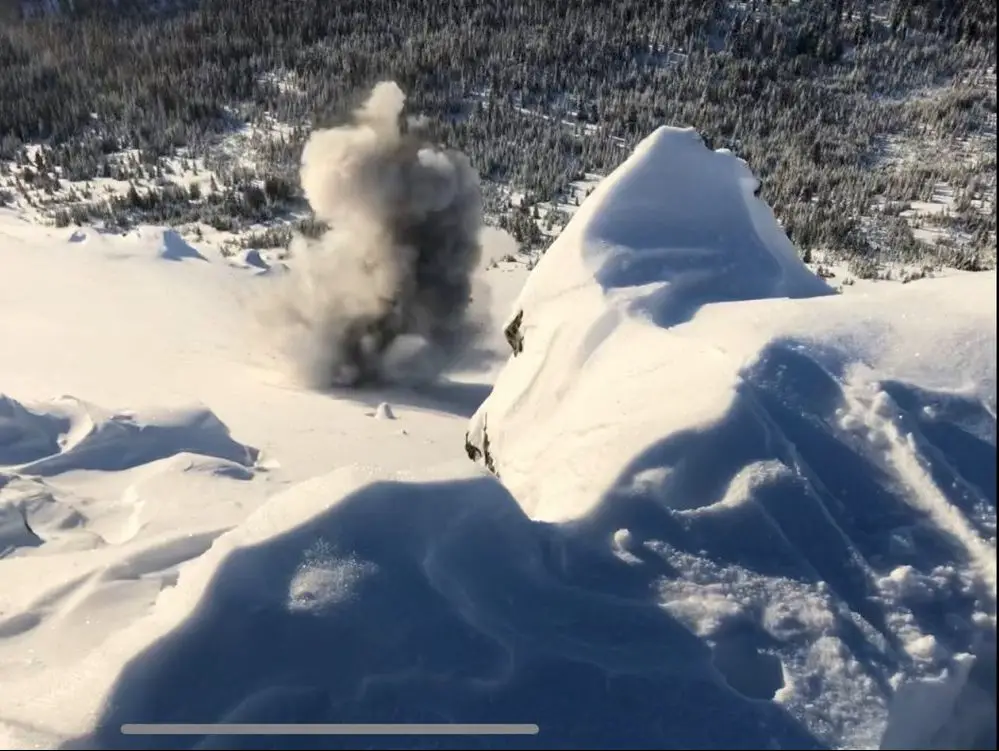In the wintery mountainous world to the north, there is an industry that booms. But it does not employ thousands, arguably does not pay a lot and does not even run year-round. Its vitality cannot be denied, despite the fact that it is overlooked and undervalued, people often ignorant of its existence. This industry is an essential component of keeping the Canadian economy chugging along and making sure that winter travelers and commuters stay safe. Winter habitation in this area of Canada would not be possible without it. And it is made possible in spectacular fashion. This is avalanche bombing.
I interviewed Mederik Delonson, Rik for short, professional avalanche technician that lives, works and plays in the Canadian Rocky Mountains. He works for a small company as a senior avalanche technician.
Rik explains how it’s not just interest in ice and fire that gets you the job:
Rik: “I networked my way into it and that is how most people end up with these kinds of higher-end forecasting jobs. They know people that own the companies, or have an in. I met my current boss at my mom’s bed and breakfast. And he liked my personality and the way I talked about things, and my personal skills, knowing that when I would have to talk to, say, the higher ups of a large company, that I would be able to come across as professional and friendly and inspire confidence in our company for these people.”
Dance With Danger
Amongst the Rocky Mountains, and any major mountain range for that matter, avalanches are inevitable. Avalanche technicians work with this inevitability to keep vital passageways functioning. There is no stopping avalanches. But we can remove humans and cargo from its path. Whenever there is enough of a risk, highways are closed and railway access is temporarily shut down in order to purposely set off some snow slide shows.
Kayla: “I don’t think that people realize, that there has to be this sort of system set up in every snowy mountain pass?”
R: “Yes, exactly. Absolutely every avalanche path that affects the railways, highways and necessary roads has been mapped and engineered. So absolutely every known path that has been mapped and proven to be an avalanche path has to be controlled and paid attention to every day.”

K: It’s interesting how the highways shut down. It’s super dangerous, and you guys have to go into the shut-down highways and into the avalanche danger before its even safe, yes?
R: “Yes. We have to expose ourselves more than anybody else out there.”
K: I’m aware that things can and do go wrong — who’s on the line?
R: “We are getting pressure from people that are sitting in an office in Alberta that have never even seen avalanche terrain before. Their goal is to get everything moving again. Which is everyone’s goal, really. Regardless, we make the ultimate calls. We always follow protocol — there is no other option — but even with that there is always risk for anyone who works in this terrain.
“There are dangerous things that can happen, but liability-wise, as long as protocols are followed, if an accident happens, it was just an accident — nobody’s true fault.
“But in the end, it is my call. If there is avalanche danger, I can stop everything — trains from running through — or I can tell people yes or no to go in where they would expose themselves to avalanche risk.”
The Allure of Avalanches
Most avalanche bombing companies bid on contracts from various groups, such as the railway or mines or highways, that need avalanche control in order to operate.
K: “And so this seems to be a thing from what you are saying, that the actual avalanche bombing company, there’s not many of you? It’s not like this is a 25 person operation?”
R: “It’s a very cutthroat industry because a lot of people are into it, and the industry is flooded with people that have the appropriate training and want all the contracts, so everyone tends to under-bid to get the contract. So … it’s … it’s cutthroat, it’s shark-y. There’s a lot of companies when it goes up for bid. Like when we get our contract re-signed at the beginning of last winter, there was 8 companies that bid on the contract and our experience was really what outbid everyone else.”
Although unsaid, I think it’s safe to say that there is not enough money to go around to pay for a large crew.
Million Dollar Mountain Closures
Money is certainly an issue of contention in more than one way for the avalanche bombing business.
K: “So, the railway hires contractors, such as the company you work for? I would have actually assumed that the government would deal with this sort of thing.”
R: “The railway is largely their own thing. They have a lot of jurisdiction.”
Apparently the trains and its contents really are a precious commodity.
R: “If a train shuts down, sometimes it’s 3-5 million dollars an hour, as soon as a train stops. If a closure lasts a full day, we are looking at tens of millions of dollars that are not getting to where they need in time. It’s pretty much tens of millions in losses.”
K: “And people don’t really stop to think about it but trains in Canada, USA, everywhere really, are headed to the ports to ship all over the world. It is one of the essential ways of getting things where they need to be.
“Coal, hot ash, all the products for the stores, grain, just trains full of grain getting to the coast to jump on a ship to go all over the place. So, it is — once you think of how much money is wrapped up in these products, closing the rail is insanely expensive — and stress-y.”
Slight Danger Is Still Danger
K: “I don’t think the general public realizes how dangerous, or how active it really is out there?”
R: “It’s incredibly active, so in the middle of the night last night, I got calls because avalanches were hitting the rails, so a train at about one in the morning ran through an avalanche that came before the train; the debris on the track was small enough that they train just punched through no problem, which is really normal actually.
“But I had to go talk to a bunch of guys that had to go clean up some of the debris and they had to actually expose themselves at an elevated hazard. They are allowed to go in, but there are lots of safety protocols. I had to send a guy in to see how big the slide was, so a guy had to literally drive in on the tracks, not stopping. They need to park in safe spots and bail out of there as soon as they see what they needed to see, and then they had to send in a snow fighter plow to clean the rest of the debris off the tracks. It’s a process.”
K: “With making all these calls, I imagine you err on the side of caution. I mean it seems you have to, that safety is the job.”
R: “It is our job to err on the side of caution.”
K: “Slight danger is still danger.”
R: “Slight danger is still danger.”
The Boom

R: “Bombing days themselves are actually pretty chill, because the natural avalanche cycle and the storm is usually done before we can fly a helicopter safely. We have to have good weather and good visibility to fly in, and minimal wind, so the actual bombing day is pretty great.
“But with that said, there is a lot of what is called remote access control units in operation now, so for example, in the nearby National Parks, they have two remote access control units, which are essentially towers set up in the mountain made to release a bomb from itself from someone on an iPad down at the highway or something.
“But the best way to actually go out and take out all the dangerous snow is by heli-bombing, so even after they use these remote systems we usually have to go out in the helicopter and carpet bomb the rest of the slopes that these things can’t reach by themselves.”
K: “What is it like to actually set off a bomb from a helicopter? It’s a physical bomb — you literally light it in the helicopter, and chuck it out?”
R: “Yes.”
K: “I imagine the novelty never really wears off?”
R: “No, it never wears off, it’s always fun. But the stress of being covered in explosives in a helicopter, the stress, or the excitement, the novelty does kind of wear off, and you just realize that that’s what you do, and everything has been engineered to be as safe as it can be. You know what to expect.”
K: “However, it has got to be pretty satisfying? It is just you more or less and just this thing, and you throw it out, and it just sets off a huge reaction.”
R: “In my life it is the biggest physical impact I’ve ever had on anything. I mean, I’ve taken out forests and to be honest, I’m not stoked about this part, but I’ve probably mass slaughtered a lot of squirrels and rabbits and maybe some goats…. but you can’t think about that part because you are saving people and that avalanche would have gone naturally anyways.”
“As long as people continue to dwell in these areas, and especially as long as we rely on transportation to the oceans, the big and the small, governments and the people will need some help maintaining their sense of normalcy, and therefore avalanche bombing will remain.”

“It’s a good thing that its necessity does not rely on others awareness of it, or that its importance is not reflective of travelers’ discontent. Yet despite there being a lack of understanding, avalanche bombing should be better understood. People in this areas and areas like it hear them go off, even see them from the right spots at ski resorts. If you spend any amount of time in these mountain resort towns you know they go off.”
K: “Yet people get so frustrated with closures!”
R: “Yup and if they didn’t close, they would have to wait longer later, when they have to dig out a buried semi-truck.”
Enough said.
*** Business, company, place names as well as the name of the interviewee have been changed or purposely left out. ***

















These are truly fantastic ideas in concerning blogging. You have touched some good
factors here. Any way keep up wrinting.